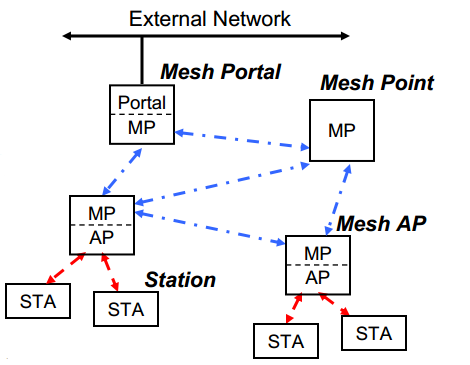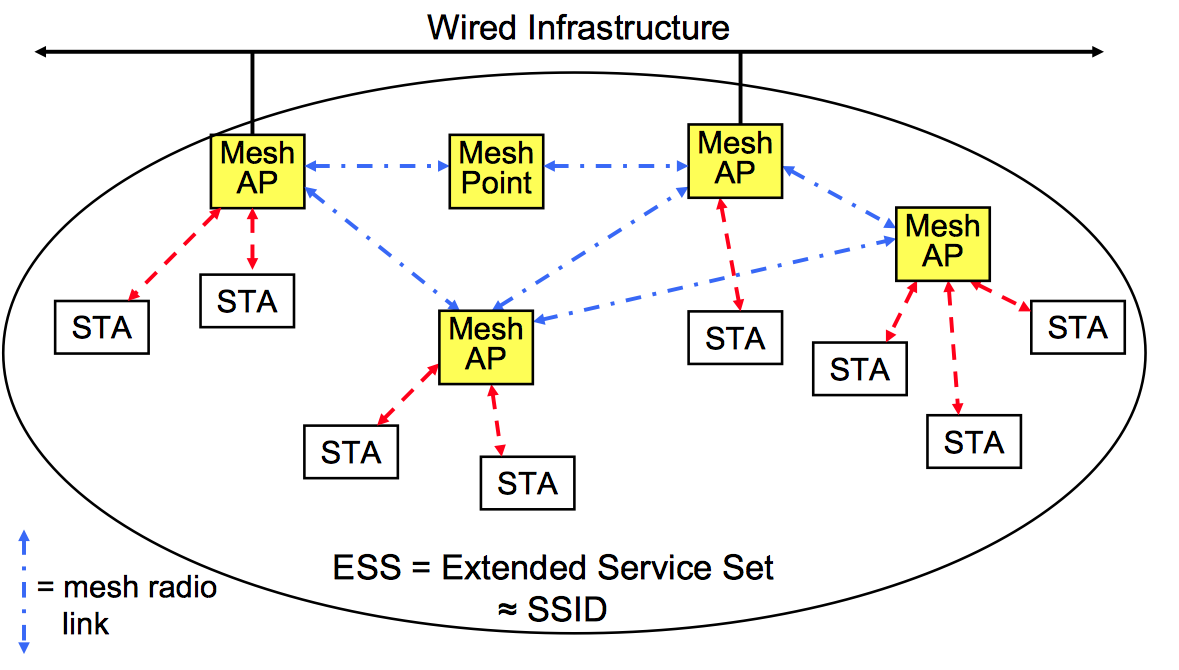IEEE 802.11s Wi-Fi Mesh for the smallest part one

Now Mesh networks are spreading around the world, and during the construction of networks you can choose between Mesh protocols, there is a BATMAN adv checked by time, there is a new and actively developed cjdns, and there is an “official” one - IEEE 802.11s
There are very little information about 802.11s in RuNet, let's talk about how it works, why it is needed and what it does.
Content:
- Why do i need
- What can
- What operating modes does it support
- Comparison with Batman / cjdns
- Why good and why not so
Why do i need
There is a trend in the world on Mesh networks, some of which are used locally and some are used globally.
The simplest example of local use is in hotels, cafes and restaurants.
When starting a Mesh network in a commercial structure, we get all the advantages of managed Mesh networks
1) No need to pull your cable to each access point
2) Points are automatically configured on the network
3) Loss of one point leads to a rebuild of routing with minimal degradation of service for subscribers
But there is global, unmanaged networks - there are a lot of them in the world en.wikipedia.org/wiki/List_of_wireless_community_networks_by_region
Obviously, in global networks, it makes no sense to use managed protocols, and indeed, it is desirable that the network itself resolves conflicts and configures itself.
What can
IEEE 802.11s Allows you to create managed networks, theoretically, you can create and not controlled, but it is not intended for this.
The protocol updates the routing tables throughout the network, works at the L2 level according to the OSI model, but you will have to configure IP addresses on each access point yourself, or use the services of the old DHCP.
He is also responsible for the search and interaction with neighboring points, the integration of new points in the Mesh network.
A Mesh network can work with both a common password and be closed or without it, encryption (as in a regular Wi-Fi network) is available only up to the access point (when using a network with a password), no tunnel end-to-end encryption - no.
To connect to a network built on the basis of IEEE 802.11s, you will need:
- Equipment that supports IEEE 802.11s
- Mesh id network
- The registered IP address on the AP or configured DHCP in the segment
If the network is password protected, the network password is added to the requirements.
What operating modes does it support
Topology in a regular network:

Topology in a Mesh network:

Mesh Point (MP) - A full member of the Mesh network, interacts with its neighbors via
Mesh AP Mesh protocols (MAP) - Allows the STA to connect to the Mesh AP
Mesh Portal (MPP) - Bridge to another network , for example, wired
Station (STA) - Output nodes from the Mesh network for connecting ordinary clients not using the Mesh protocol
Comparison with Batman / cjdns
802.11s differs from BATMAN / cjdns in that there is currently no free implementation for UNIX for it, but here they are trying to do it.
In addition, BATMAN adv has already been tested for many years, showing its stability, and there’s no iron support worth forgetting.
Compared to cjdns, the protocol has the same disadvantages as everyone else (except netsukuku)
- Lack of end-to-end encryption
- Inability to connect mesh segments with tunnels over the Internet
- No decentralized generation of IP addresses
Why good and why not so
Thus, it turns out that the 802.11s protocol, however, like Batman, is excellent for building managed mesh networks , but self-organizing ones should be given to other technologies - ntsukuku / cjdns.
If you are interested in publications on 802.11s, next time we will consider with you:
1) Routing on an 802.11s network
2) Setting up a centralized Internet connection from 802.11s mesh networks
3) Combining 2 Lan networks and 1 mesh into one common
PS Results registration on the map (in the cjdns project), why this is needed and what next - will be a little later
